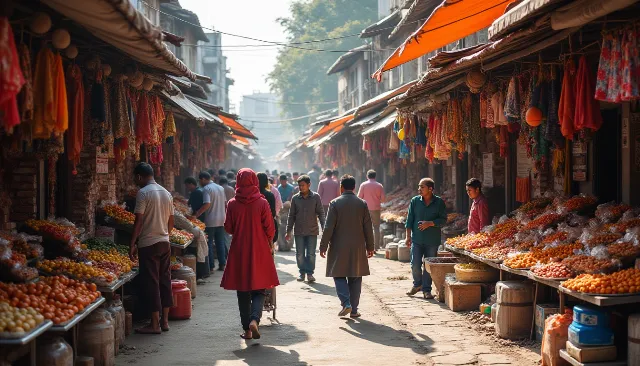Ganesh Chaturthi, one of the most celebrated festivals in India, is a joyous occasion that marks the birth of Lord Ganesha, the elephant-headed god of wisdom, prosperity, and remover of obstacles. This festival, observed with great fervor and enthusiasm, is a time for families and communities to come together in worship, celebration, and devotion.

The festival typically falls in the month of Bhadrapada (August or September), depending on the lunar calendar, and lasts for 10 days, culminating in a grand procession known as Visarjan, where the idols of Lord Ganesha are immersed in water.
Table of Contents
1. The Significance of Ganesh Chaturthi
Ganesh Chaturthi is not just a religious festival; it is a cultural celebration that brings together people from different walks of life, fostering unity and brotherhood. The day honors the birth of Lord Ganesha, believed to be created by Goddess Parvati out of clay and brought to life by Lord Shiva. According to Hindu mythology, Ganesha is revered for his wisdom, intellect, and ability to remove obstacles in the lives of his devotees.
Mythological Significance:
The story of Lord Ganesha’s creation is deeply rooted in Hindu mythology. As the tale goes, Goddess Parvati created Ganesha from the sandalwood paste that she used for bathing and gave him life. When Lord Shiva returned home, he did not recognize Ganesha, and a conflict ensued, during which Lord Ganesha’s head was severed.
To restore him, Lord Shiva sent his followers to fetch the head of the first living being they encountered, which turned out to be an elephant. The elephant’s head was placed on Ganesha’s body, and thus, he became the beloved deity with the elephant head.
2. The Rituals of Ganesh Chaturthi
The celebration of Ganesh Chaturthi involves a series of rituals, prayers, and festive activities that vary from region to region, but the central theme remains the same: reverence for Lord Ganesha.
Ganesha Idol Installation (Pranapratishtha):
The festivities begin with the installation of Ganesha idols in homes and public places. Devotees carefully select idols made from clay or eco-friendly materials and perform the Pranapratishtha ceremony, wherein they invoke Lord Ganesha’s presence in the idol with prayers, mantras, and offerings of flowers, fruits, and sweets, particularly modaks (a sweet dumpling thought to be Lord Ganesha’s favorite). Homes and pandals (temporary temples) are decorated with vibrant colors and lights, setting the stage for a joyous celebration.
Puja and Aarti:
Every day of the festival, devotees offer prayers and perform aarti (a devotional ritual involving the waving of a lighted lamp in front of the idol) to Lord Ganesha. The aarti, along with chanting of mantras and singing bhajans, creates a spiritually charged atmosphere. The most famous aarti is “Ganapati Bappa Morya,” which is sung with great enthusiasm during the evening puja. Devotees also offer coconut, jaggery, flowers, and sweets to the idol as a symbol of their devotion.
Cultural Programs and Community Gatherings:
Ganesh Chaturthi is not just about religious rituals; it is a time for community celebrations. In many places, especially in cities like Mumbai, public celebrations include cultural events such as music, dance, and drama performances. Ganesh pandals host competitions, organize processions, and offer a platform for local artists to showcase their talents. The atmosphere is vibrant, with crowds gathering to sing and dance in honor of Lord Ganesha.
The Final Day: Visarjan (Immersion):
The culmination of Ganesh Chaturthi comes on the 10th day of the festival, known as Visarjan. On this day, the idols of Lord Ganesha are taken in grand processions to water bodies such as rivers, lakes, and seas for immersion. The processions are filled with excitement, music, and devotion, with devotees chanting Ganapati Bappa Morya, Pudhchya Varshi Laukariya (Ganapati Bappa, we will welcome you again next year). Immersion symbolizes the return of Lord Ganesha to his celestial abode, after blessing his devotees with his presence for the 10-day celebration.
3. The Cultural Importance of Ganesh Chaturthi
Ganesh Chaturthi is not only a religious observance but also a cultural spectacle. In the cities and villages across India, the festival is celebrated with immense zeal and joy, bringing together people of all ages, backgrounds, and communities. The vibrant decorations, the music, the dance, and the delicious food all contribute to the communal spirit of the festival. It fosters unity, as people from different walks of life come together to celebrate their devotion to Lord Ganesha.
Environmental Awareness:
In recent years, there has been a growing awareness of the environmental impact of the festival, particularly regarding the immersion of idols made from non-biodegradable materials such as plaster of Paris. As a result, there has been a push towards using eco-friendly idols made from clay, which do not pollute the water bodies. Many communities are also adopting “green” practices, such as limiting the use of plastic and opting for natural materials for decorations.
4. Ganesh Chaturthi Around India
While Ganesh Chaturthi is celebrated all over India, its observance is especially prominent in Maharashtra, where the festival has reached grand proportions, particularly in Mumbai. The city is known for its huge public Ganesh pandals, where thousands of devotees come together to worship Lord Ganesha. In other states like Karnataka, Gujarat, and Andhra Pradesh, the festival is also observed with great devotion, although with some regional variations in rituals and celebrations.
Maharashtra and Mumbai:
In Maharashtra, especially Mumbai, the festival is marked by the grand Ganesh processions, which are among the most famous in the world. Public pandals are set up with elaborately decorated idols, and the atmosphere is charged with excitement and devotion. The Visarjan processions are a major highlight, with huge crowds participating in the rituals.
Southern India:
In Southern India, especially in Tamil Nadu and Andhra Pradesh, Ganesh Chaturthi is celebrated with religious fervor. While the festival in these regions is typically more subdued than in Maharashtra, it still holds deep cultural and religious significance. In Tamil Nadu, for instance, clay idols of Lord Ganesha are often installed in homes, and prayers are offered for prosperity and happiness.
5. The Spiritual and Social Message of Ganesh Chaturthi
Ganesh Chaturthi is a festival that teaches us important life lessons. Lord Ganesha is revered for his wisdom and intelligence, and devotees often seek his blessings for knowledge, success, and prosperity. The festival is a reminder that obstacles can be overcome through faith, perseverance, and devotion. The immersion of the Ganesha idol also symbolizes the transient nature of life, reminding people to cherish moments of joy and to accept the inevitability of change.
The festival promotes values of unity, love, and the importance of family and community. It is a time for people to come together, regardless of their differences, to celebrate the divine blessings of Lord Ganesha.
Conclusion
Ganesh Chaturthi is a vibrant and joyous celebration of Lord Ganesha’s birth, marked by devotion, cultural traditions, and a deep sense of community. It is a festival that transcends regional and religious boundaries, bringing people together in worship and celebration. The energy, the devotion, and the festive atmosphere make Ganesh Chaturthi one of the most beloved festivals in India, spreading joy and good fortune to all who participate in the celebrations.


